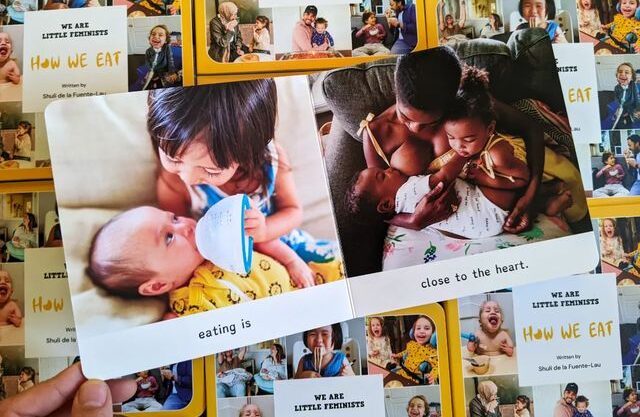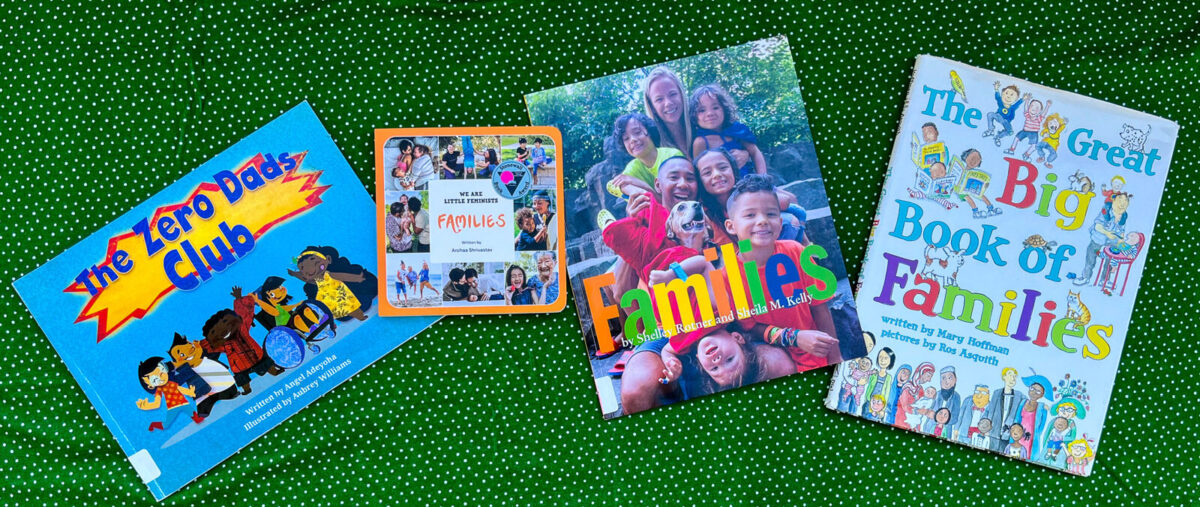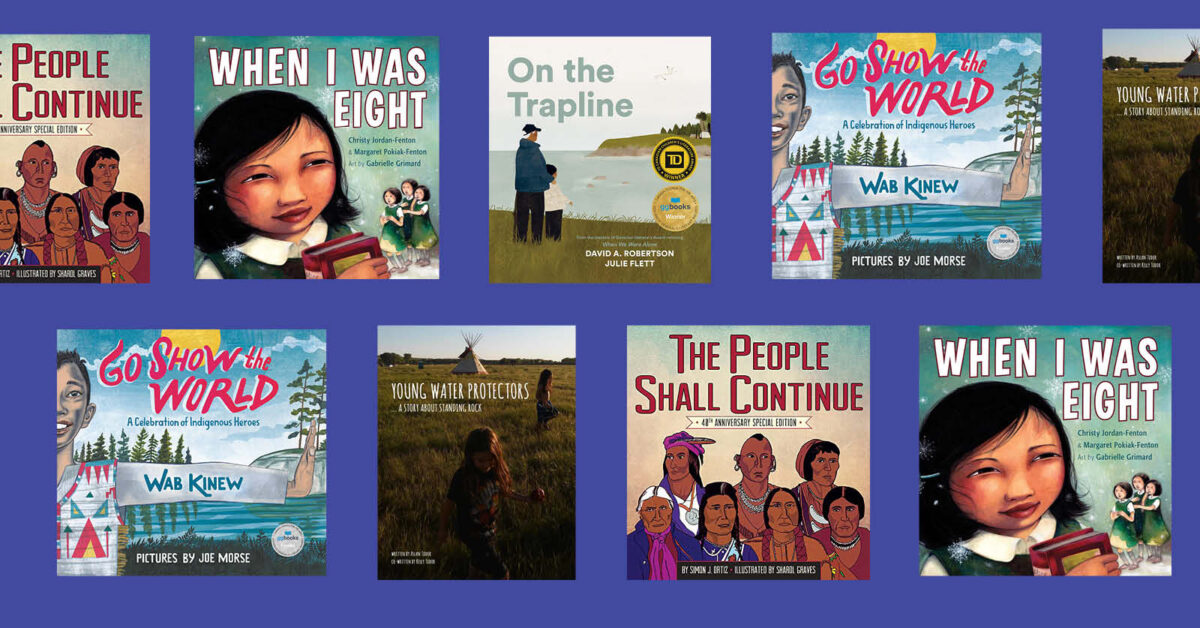Our board book How We Eat (the 5th book in our We Are Little Feminists board book series) celebrates all the different ways we eat (such as with spoons, chopsticks, and G-tubes), helping families and educators discuss ability, culture, and food.
We wrote this book to make space for kiddos to notice and ask about differences at mealtime! Encourage conversations about all types of bodies and customers so that stereotypes or assumptions do not persist. Need help explaining to your little(s) what’s happening on each page? Read our explanations for each page below!
Page 1 – Syringe Feeding
 A syringe or finger feeding is an alternate way of feeding when nursing from the breast is not possible or an option. It involves filling a small syringe with breast milk or formula. Syringe feeding might be beneficial in instances of tongue/lip tie, or cleft lip, to give babies small amounts of colostrum, if a baby is recovering from birth interventions, or if a mother is unable to feed a baby temporarily.
A syringe or finger feeding is an alternate way of feeding when nursing from the breast is not possible or an option. It involves filling a small syringe with breast milk or formula. Syringe feeding might be beneficial in instances of tongue/lip tie, or cleft lip, to give babies small amounts of colostrum, if a baby is recovering from birth interventions, or if a mother is unable to feed a baby temporarily.
A similar variation of syringe feeding is finger feeding, when a tube taped to a finger is offered to the baby, to encourage a similar sucking technique to breastfeeding.
Page 2 – Nasogastric tube
 Babies generally do not coordinate the breathing, sucking, and swallowing necessary for feeding until 34-36 weeks. If a baby is born before that or if a full-term baby who has a hard time with those skills, a feeding tube or NG (nasogastric) tube might be necessary. (About 50% of twins are considered premie babies.) A feeding tube is a soft plastic tube placed in the nose or mouth, leading to the stomach, or sometimes the small intestine. An NG tube is used when tube feeding is necessary for less than 3 months.
Babies generally do not coordinate the breathing, sucking, and swallowing necessary for feeding until 34-36 weeks. If a baby is born before that or if a full-term baby who has a hard time with those skills, a feeding tube or NG (nasogastric) tube might be necessary. (About 50% of twins are considered premie babies.) A feeding tube is a soft plastic tube placed in the nose or mouth, leading to the stomach, or sometimes the small intestine. An NG tube is used when tube feeding is necessary for less than 3 months.
Page 3 – Bottle Feeding
 Bottle feeding is another way for a baby to drink milk. Babies who bottle feed drink formula milk, pumped breast milk, or both. Some babies drink exclusively pumped milk if they don’t get enough milk through breastfeeding, cannot latch, or other reasons that best benefit the mother-child relationship.
Bottle feeding is another way for a baby to drink milk. Babies who bottle feed drink formula milk, pumped breast milk, or both. Some babies drink exclusively pumped milk if they don’t get enough milk through breastfeeding, cannot latch, or other reasons that best benefit the mother-child relationship.
Page 4 – Breastfeeding or chestfeeding
 Breastfeeding or chestfeeding babies drink milk directly from the body. Breast milk naturally contains the antibodies, nutrients, and vitamins a baby needs. Breastfeeding may come with challenges, such as: mastitis, engorgement, not enough or too much breastmilk, blocked ducts, or latching difficulties.
Breastfeeding or chestfeeding babies drink milk directly from the body. Breast milk naturally contains the antibodies, nutrients, and vitamins a baby needs. Breastfeeding may come with challenges, such as: mastitis, engorgement, not enough or too much breastmilk, blocked ducts, or latching difficulties.
Page 5 – Traditional weaning
 Around 6 months old, babies start eating foods other than milk. Traditional weaning or spoon-fed weaning are when babies are fed purees. They are slowly introduced to mashed and chopped food, then finger food. In this picture, an older sibling is feeding store-bought puree to his little brother. This little brother is on the Autism spectrum and loves eating pureed food.
Around 6 months old, babies start eating foods other than milk. Traditional weaning or spoon-fed weaning are when babies are fed purees. They are slowly introduced to mashed and chopped food, then finger food. In this picture, an older sibling is feeding store-bought puree to his little brother. This little brother is on the Autism spectrum and loves eating pureed food.
Page 6 – Baby-led weaning
 Baby-led weaning is a method of weaning when babies are 6 months older and demonstrate developmental readiness to feed themselves. They are exposed to soft finger-size foods as part of their family mealtime.
Baby-led weaning is a method of weaning when babies are 6 months older and demonstrate developmental readiness to feed themselves. They are exposed to soft finger-size foods as part of their family mealtime.
Page 7 – Fork
 A fork is a universal utensil that is used to pierce or scoop food. Some Southeast Asian cultures use a fork and spoon together, the fork used to cut food and to move food into the spoon. A number of European cultures use a fork and knife together, though hand placement and cutting methods differ.
A fork is a universal utensil that is used to pierce or scoop food. Some Southeast Asian cultures use a fork and spoon together, the fork used to cut food and to move food into the spoon. A number of European cultures use a fork and knife together, though hand placement and cutting methods differ.
Page 8 – Spoon
 A spoon is used to scoop up soup or softer foods. This toddler uses an adaptive spoon to help him eat applesauce. Adaptive spoons help kids with limb differences or other disabilities independently eat. Nutritional rehab programs can help kids grow in their independent and healthy eating skills.
A spoon is used to scoop up soup or softer foods. This toddler uses an adaptive spoon to help him eat applesauce. Adaptive spoons help kids with limb differences or other disabilities independently eat. Nutritional rehab programs can help kids grow in their independent and healthy eating skills.
Page 9 – Slurping
 In Japanese culture, slurping noodles is regarded as a sign of appreciation and enjoyment of a meal. Originally this practice was started with the invention of soba noodles 400 years ago, but has soon expanded to include other noodles.
In Japanese culture, slurping noodles is regarded as a sign of appreciation and enjoyment of a meal. Originally this practice was started with the invention of soba noodles 400 years ago, but has soon expanded to include other noodles.
“Our routine is to say [in Japanese] “itadakimasu” before eating and “gochisosama” after eating. The[se] are appreciative words for the food and for [those] who cooked [it]. Meal time is family time for me and also my daughters. We talk about many things that each member feels and does each day. When my daughters eat happily, I know they are healthy!” – Nao Ikeda
Page 10 – Sipping or drinking
 This child is sipping a homemade smoothie. As children are weaned off a sole milk diet, they learn to drink liquids by sipping. Some kids are solely on a liquid diet if they are preparing for or recovering from a surgery or have food aversions.
This child is sipping a homemade smoothie. As children are weaned off a sole milk diet, they learn to drink liquids by sipping. Some kids are solely on a liquid diet if they are preparing for or recovering from a surgery or have food aversions.
Page 11 – Gastrostomy tubes
 In this picture, this child has a tracheostomy tube and a gastrostomy tube. His tracheostomy tube helps keep his windpipe open for breathing. While individuals with tracheostomy tubes can eat through the mouth, suction prior to the meal, eating small bites, and sitting upright while eating is necessary.
In this picture, this child has a tracheostomy tube and a gastrostomy tube. His tracheostomy tube helps keep his windpipe open for breathing. While individuals with tracheostomy tubes can eat through the mouth, suction prior to the meal, eating small bites, and sitting upright while eating is necessary.
In the bottom right corner, a caregiver is giving him his meal through a large syringe attached to the gastrostomy tube (G-tube). The G-tube (not pictured) is a tube that passes through the abdominal wall into the stomach. It is used by individuals who have a difficult time getting nutrients by mouth.
Page 12 – Dipping foods
 The children are dipping steamed artichoke leaves in melted butter. Many cultures have food that involves dipping – such as roti dipped in dal, tortilla chips in guacamole, buffalo wings or fresh vegetables in dressing, and or Filipino meat or fish in toyomansi.
The children are dipping steamed artichoke leaves in melted butter. Many cultures have food that involves dipping – such as roti dipped in dal, tortilla chips in guacamole, buffalo wings or fresh vegetables in dressing, and or Filipino meat or fish in toyomansi.
Page 13 – Chopsticks
 Chopsticks are used by many Asian cultures to eat a variety of foods- from noodles to rice to pretty much anything! Chopsticks originated in China in 1200 BCE but are used worldwide because of the Asian diaspora. Training chopsticks with finger holds (not pictured) is one-way children learn how to use chopsticks.
Chopsticks are used by many Asian cultures to eat a variety of foods- from noodles to rice to pretty much anything! Chopsticks originated in China in 1200 BCE but are used worldwide because of the Asian diaspora. Training chopsticks with finger holds (not pictured) is one-way children learn how to use chopsticks.
Page 14 – Eating with hands
 In almost every cuisine, there is food eaten with the hands. This child is eating dosa (a thin pancake), idli (a savory rice cake made from fermented rice and lentil batter), and chutney. Dosas and idlis are a common South Indian and Sri Lankan breakfast (and sometimes dinner) meal. Other hands-only dishes include Mexican tostadas, Ethiopian injera, Malaysian banana leaf rice, and Mediterranean mezze.
In almost every cuisine, there is food eaten with the hands. This child is eating dosa (a thin pancake), idli (a savory rice cake made from fermented rice and lentil batter), and chutney. Dosas and idlis are a common South Indian and Sri Lankan breakfast (and sometimes dinner) meal. Other hands-only dishes include Mexican tostadas, Ethiopian injera, Malaysian banana leaf rice, and Mediterranean mezze.
Page 15 – Family meals
 Children eat together first with their family or caregiver. Family meals are often a time to share family values, family stories, and a way for children to learn about the cultures and traditions that are important to their families.
Children eat together first with their family or caregiver. Family meals are often a time to share family values, family stories, and a way for children to learn about the cultures and traditions that are important to their families.
“Our mealtime routine is to wash our hands and sit down together to eat as a family. Mealtime for us is a chance to talk about our day, tell jokes and laugh!” – Cheryl Lala
Page 16 – G-tube role playing
 The most common kind of feeding tubes are gastrostomy tubes (or G-tubes). Other kinds include PEG tubes, long tubes, or low profIle tubes or buttons. This older sibling is feeding their younger brother through a syringe connected to a G-tube. G-tubes can be attached to the stomach with medical tape, a securement device (such as a Grip-Lok) or forming a tab to pin onto the clothes. We love that the teddy bear pictured here also has a G-tube!
The most common kind of feeding tubes are gastrostomy tubes (or G-tubes). Other kinds include PEG tubes, long tubes, or low profIle tubes or buttons. This older sibling is feeding their younger brother through a syringe connected to a G-tube. G-tubes can be attached to the stomach with medical tape, a securement device (such as a Grip-Lok) or forming a tab to pin onto the clothes. We love that the teddy bear pictured here also has a G-tube!
Page 17 – Eating food from a street vendor
 These children are eating fruit from a street fruit vendor. Many street fruit vendors in the US have roots in Central and South America, where they are known as ambulantes and where the practice dates back to pre-Hispanic times.
These children are eating fruit from a street fruit vendor. Many street fruit vendors in the US have roots in Central and South America, where they are known as ambulantes and where the practice dates back to pre-Hispanic times.
Page 18 – Allergies
 This page captures the experience of many families who live with allergies. Checking the ingredient list on packaged products, asking a waiter if a certain ingredient is present in a dish, making sure a host knows about a certain allergy, or having allergy medication or an EpiPen nearby is a reality for 5.6 million families with children with allergies in the US.
This page captures the experience of many families who live with allergies. Checking the ingredient list on packaged products, asking a waiter if a certain ingredient is present in a dish, making sure a host knows about a certain allergy, or having allergy medication or an EpiPen nearby is a reality for 5.6 million families with children with allergies in the US.
“Mealtime is very important to us, but the most important aspect is ensuring that everyone at the table is safe – psychologically safe and physically safe. Part of physical safety for our family means navigating our oldest child’s severe food allergies. As such, we have learned to recognize and respond to the signs and symptoms of an allergic reaction, we educate our kiddo on how to read food labels, and we always have two epinephrine auto-injectors on hand (even when it’s not mealtime!). We are so appreciative of those in our lives who also prioritize keeping folks with allergies safe- whether it is a family member, a dear friend, a neighbor, or the CEO of a food company who believes in transparent labeling. Here’s to mealtime- may it be safe and enjoyable for all. If you want to learn more about food allergies, you can visit foodallergy.org.” – Amanda Jaskiewicz
Page 19 – Cafe
 This mother and child are enjoying a warm drink and pastries at a cafe. The cafe industry is a growing industry, as many people enjoy meeting, socializing, working, and enjoying a drink, snack, or meals at cafes.
This mother and child are enjoying a warm drink and pastries at a cafe. The cafe industry is a growing industry, as many people enjoy meeting, socializing, working, and enjoying a drink, snack, or meals at cafes.
Page 20 – Birthdays
 Birthdays are occasions to enjoy one’s favorite food and desserts! Birthdays are often joyous times that bring people together.
Birthdays are occasions to enjoy one’s favorite food and desserts! Birthdays are often joyous times that bring people together.
“Mealtime to us as a family means coming together to regroup after a long day. No phones or TV, but time to pause from the busyness of the day to focus on each other and talk about our days – the good things and sometimes the hard things.” – Amanda Woods
Page 21 – Cooking together
 In this picture, two kids and their grandfather are making dumplings together. Making food and eating food together is a common way to pass down a favorite dish, cultural food, or food memory through the generations.
In this picture, two kids and their grandfather are making dumplings together. Making food and eating food together is a common way to pass down a favorite dish, cultural food, or food memory through the generations.
“Mealtime is absolutely precious to us. Dad is Taiwanese American and mom is a Korean American, classically trained in French cuisine! Not surprisingly, meal times are when we explore multicultural and often fusion dishes. Both of our parents grew up using chopsticks so we enjoy honing our skills as well!
Here, our grandparents were visiting us and they were teaching us how to make dumplings from scratch. Grandma’s recipe is so yummy and grandpa has gotten so good at helping to make them. We’re not too shabby ourselves and are always ready to roll up our sleeves to help.” – Amy Park
Page 22 – Sweet treat
 A cupcake will almost always bring a smile!
A cupcake will almost always bring a smile!
“Mealtime means having fun as a family; helping each other grow strong; supporting each other. Sometimes we eat food to celebrate special occasions like birthdays, and it brings us all together to the dinner table (even those of us who need extra support to sit!).
My daughter Lucy usually needs to be fed by an adult, so we try to take turns so that we can all enjoy mealtime, both the meal and the conversation. Although it’s often easier to eat after the kids do because of this, we try to eat at the same time as much as we can to model good habits (but it’s hard and sometimes we just do our best!). I like this picture because it shows that food can be fun and exciting, and that all food nourishes us, even (especially?) cupcakes.” – Annie Slacter






 in Oakland, CA
in Oakland, CA